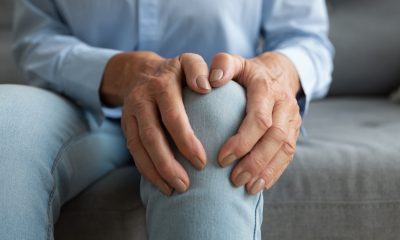Research
Novel method could measure key marker of biological ageing

A new scientific approach from a Singapore-led collaboration of researchers, could provide information on how rapidly we are ageing and what we need to do to slow it down.
Telomeres—the caps at the ends of chromosomes that protect our genetic materials from the brunt of cellular wear and tear—are known to shorten and fray over time.
Lifestyle, diet and stress can exacerbate this process, leading to early loss of telomere protection and increasing the chances of early ageing and lifestyle diseases, such as cancer and heart diseases.
To date, approaches for measuring biological ageing based on telomere length have been limited as they can only ascertain average telomere lengths within a pool of DNA fragments, or are time-consuming and require highly-skilled specialists. Being able to accurately and efficiently measure the length of an individual’s telomeres could open the doors to developing lifestyle interventions that slow ageing and prevent disease.
Published in the journal, Nature Communications, scientists at Duke-NUS Medical School, National Heart Centre Singapore (NHCS) and colleagues in Singapore, China and the USA have recently devised a way to rapidly and precisely measure the length of a single telomere.
Associate Professor Li Shang, senior author of the study from Duke-NUS Cancer & Stem Cell Biology Programme, explained: “We applied a novel approach that uses DNA sequences—we call them ‘telobaits’—to latch onto the ends of telomeres in large pools of DNA fragments, like fishing in pond. Then, with specific scissor-like enzymes, we snip the telomeres out of the pools.
“Using high-throughput genetic sequencing technology, we were able to read the DNA ‘letters’ that comprised each individual telomere, allowing us to very precisely measure their lengths.”
The team successfully validated this approach when they tested it using human cell lines and patient cells. Interestingly, the sequencing results revealed that the genetic sequences within certain parts of the telomeres, known as telomeric variant sequences, were distinct to each individual person.
“Based on this insight, a future area of study for us is the possible use of telomeric variant sequences as a means of biological identification, which could potentially prove useful for expanding the field of forensic science,” added Associate Professor Li.
The team believes this new approach could be used as a predictive biomarker for human ageing and disease at the individual level, as well as for population-level studies on the impacts of lifestyle, diet and the environment on human health.
Senior co-author of the study, Associate Professor, Angela Koh, who is a senior consultant with the Department of Cardiology at NHCS and Associate Professor with the SingHealth Duke-NUS Cardiovascular Sciences Academic Clinical Programme, commented: “This method for telomere length measurement is an important advance in the field of ageing research. From the clinical perspective, we view this as a very promising method for understanding clinical diseases associated with ageing such as cardiovascular disease.
“Our partnership signifies what can be achieved by clinician-and-biomedical scientists to bring complex lab methods towards simpler, quantifiable methods that may be used in broader clinical labs in the future.”

Using home-grown designed telomeric-DNA sequences, called ‘Telobaits‘, and highly-advanced DNA sequencing technology, scientists can now precisely determine the length of a single telomere from an individual. This technique could potentially be used to measure the impact of lifestyle or drug interventions to tackle ageing-related diseases. Credit: Dr Javier Koh, Duke-NUS Medical School.
Research
Brain shape changes could offer early warning signs of dementia, study suggests

Ageing alters the brain’s shape in measurable ways that could provide early warning signs of dementia, potentially years before symptoms appear, researchers say.
Analysis of more than 2,600 brain scans from adults aged 30 to 97 revealed significant alterations in brain geometry linked to declines in memory, reasoning and other cognitive functions.
The inferior and anterior parts of the brain expanded outward, while the superior and posterior regions contracted inward. These uneven shifts were most evident in older adults showing cognitive decline.
Researchers at the University of California, Irvine’s Centre for the Neurobiology of Learning and Memory found that people with more pronounced posterior compression performed worse in reasoning tests, suggesting these geometric markers directly relate to brain function.
“Most studies of brain ageing focus on how much tissue is lost in different regions,” said Niels Janssen, senior author and professor at Universidad de La Laguna in Spain and visiting faculty at the CNLM.
“What we found is that the overall shape of the brain shifts in systematic ways, and those shifts are closely tied to whether someone shows cognitive impairment.”
One important implication involves the entorhinal cortex – a small but vital memory hub in the medial temporal lobe.
The study suggests age-related reshaping may press this region against the hard base of the skull.
The entorhinal cortex is one of the first areas where tau, a toxic protein linked to Alzheimer’s disease, accumulates.
The findings raise the possibility that mechanical and gravitational forces may contribute to its vulnerability in Alzheimer’s – a potential disease mechanism not previously considered.
“This could help explain why the entorhinal cortex is ground zero of Alzheimer’s pathology,” said study co-author Michael Yassa, director of the CNLM and James L McGaugh endowed chair.
“If the ageing brain is gradually shifting in a way that squeezes this fragile region against a rigid boundary, it may create the perfect storm for damage to take root. U
“nderstanding that process gives us a whole new way to think about the mechanisms of Alzheimer’s disease and the possibility of early detection.”
The researchers say their geometric approach could eventually provide new markers for identifying dementia risk, potentially before symptoms emerge.
“This isn’t just about measuring brain shrinkage,” added Janssen.
“It’s about seeing how the brain’s architecture responds to ageing and how that architecture predicts who is more likely to struggle with memory and thinking.”
The patterns were replicated in two independent datasets, reinforcing the consistency of these shape changes as a hallmark of ageing.
“We’re just beginning to unlock how brain geometry shapes disease,” said Yassa.
“But this research shows that the answers may be hiding in plain sight – in the shape of the brain itself.”
News
Research uncovers ageing secrets of world’s oldest woman

Scientists have discovered the genetic and lifestyle factors that helped Spanish woman Maria Branyas live to 117, making her the world’s oldest person until her death last year.
Researchers found Ms Branyas’s “exceptional” genes and a “frugal” Mediterranean diet – rich in vegetables, fruits, legumes and olive oil – were the most likely reasons for her longevity.
The study collected samples of blood, saliva and stool from Ms Branyas when she was 116. She showed no sign of dementia and had a biological age 23 years younger than her chronological age.
The research, involving academics from the University of Leicester, also included Prof Manel Esteller of the Josep Carreras Leukaemia Research Institute in Barcelona.
Prof Esteller, who led the team, noted that Ms Branyas did not drink alcohol or smoke and ate three servings of plain, sugar-free yoghurt every day.
“She had an exceptional genome enriched in variants in genes that are associated with enhanced lifespan in other species, such as dogs, worms and flies,” said Prof Esteller.
“At the same time, she was devoid of gene variants associated with the risk of pathologies such as cancer, Alzheimer’s and metabolic disorders.”
Prof Esteller said Ms Branyas carried many gene variants that kept blood lipid levels low, protecting her heart and cognition. Lipids are fat-like substances in blood and tissues that can cause high cholesterol.
Blood tests also revealed her lipid metabolism – how the body processes fats – was among the most efficient ever reported.
“This was related to her frugal diet and genes that quickly metabolised damaging molecules,” Prof Esteller added.
The team said they suspected her daily yoghurt also helped replenish levels of a probiotic called bifidobacterium, which can reduce inflammation and slow ageing.
Prof Esteller approached Prof Salvador Macip, from the division of molecular and cell biology at the University of Leicester, to contribute to the study.
Dr Thong Cao, from the university’s cardiovascular sciences department, worked on plasma samples from Ms Branyas.
He said: “Our role was to use advanced mass spectrometry to study thousands of proteins circulating in the blood of this exceptionally long-lived individual.
“Proteins are the molecular ‘workhorses’ of the body and provide important clues about health and disease.
“By comparing her protein profile with those of other women across different age groups, we could see what was unique about her biology.”
Analysis in Leicester found her blood proteins suggested “a very low level” of inflammation.
Data also showed she had enhanced detoxification and antioxidant responses, suggesting her body had strong mechanisms to counteract cellular stress – damage to cells that can lead to ageing and disease.
Research
Genetic condition puts Black and South Asian men at greater diabetes risk

A genetic deficiency affecting thousands of black and South Asian men in the UK could delay diabetes diagnosis by making routine blood tests inaccurate, new research has reveals.
Around one in seven black men and one in 63 South Asian men have G6PD deficiency, compared with fewer than one in 100,000 white men.
Despite this, fewer than one in 50 affected men are clinically recognised.
The condition affects red blood cells, making standard diabetes checks appear artificially low and underestimating real blood sugar levels.
Men with G6PD deficiency have a 37 per cent higher risk of serious complications linked to type 2 diabetes, including eye, kidney and nerve damage.
Professor Ines Barroso, of the University of Exeter, said: “Our findings highlight the urgent need for changes to testing practices to tackle health inequalities.
“Without the reliable tools they need, healthcare professionals risk missing or misdiagnosing type 2 diabetes.”
G6PD is a protein found in red blood cells, which carry oxygen around the body.
These cells typically live for about three months before being replaced, and G6PD helps protect them against substances that would otherwise make them break down too early.
In people with the deficiency, the cells lack enough G6PD.
When exposed to certain chemicals in foods or medicines, the red blood cells may die off too soon, leading to anaemia and other health problems.
While the deficiency does not cause diabetes, it can affect test results.
Diabetes is usually diagnosed and monitored with an HbA1c test, which measures average blood sugar levels over the past two to three months by checking how much glucose is attached to haemoglobin in red blood cells.
Researchers said G6PD deficiency can make HbA1c readings appear lower than they should, underestimating true blood sugar levels.
Experts called the findings “deeply concerning” and warned that standard diabetes tests may not be accurate for those with the condition.
Dr Esther Mukuka, director of research inclusion at the NIHR, which supported the study, added: “Addressing the impact of G6PD deficiency on diabetes testing is an important step towards reducing inequalities and making sure that everyone, regardless of background, benefits equally from medical advances.”

 News2 months ago
News2 months agoResearch sheds light on what it means to be middle-aged

 News4 weeks ago
News4 weeks agoAir pollution can drive devastating forms of dementia, study suggests

 Wellness3 days ago
Wellness3 days agoWeight loss jabs should be first-line obesity treatment in most cases, new guidance states

 News2 months ago
News2 months agoGetting a hearing aid before 70 may sharply cut dementia risk, study shows

 Wellness3 weeks ago
Wellness3 weeks agoFunding boost for first potentially regenerative treatment for MS

 Markets & Industry1 month ago
Markets & Industry1 month ago£29.6m UK facility to accelerate therapies for cancer and heart disease

 News2 weeks ago
News2 weeks agoDrinking even small amounts of alcohol may increase dementia risk, study finds

 News2 months ago
News2 months agoFull-fat milk tied to higher heart death risk






































